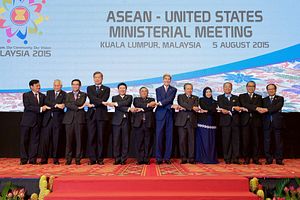The ASEAN Foreign Ministers Meeting (AMM) has undergone unprecedented high turnover in recent times. How will the changes affect the camaraderie — the much-prized “we feeling” — in this crucial ASEAN body?
The AMM is now under the chairmanship of the newly-appointed Laos Foreign Minister Saleumxay Kommasith, who was previously a vice minister of foreign affairs, and the Lao PDR’s permanent representative to the United Nations in New York. His predecessor as foreign minister, 71-year-old Thongloun Sisoulith, has been promoted to head a new cabinet as the prime minister. Saleumxay will host the 49th AMM and the 23rd ARF July 21-26. At 47 years old, he will be the youngest ASEAN foreign minister in recent memory to serve as the AMM Chairman.
A well-known newcomer to the AMM is Myanmar’s Daw Aung San Suu Kyi, leader of the NLD. In addition to holding the post of foreign minister, Suu Kyi is concurrently minister of the president’s office, spokesperson for the president, and state counselor.
Another new face, less well-known overseas, is Cambodia’s Prak Sokhon, who was previously minister of telecommunications. Prak Sokhon succeeds 80-year-old Hor Namhong, who had served as the minister of foreign affairs and international cooperation since 1998. Hor Namhong now holds only one post, as a deputy prime minister in the new Cabinet approved by the Cambodian National Assembly on April 4.
The Philippines will also have new representation at the AMM. Albert del Rosario stepped down as the secretary of foreign affairs of the Philippines on March 7, 2016, after five years in office. His successor is Jose Almendras, a former cabinet secretary and secretary of energy. His service will end along with the end of the six-year term of President Benigno Aquino III in June 2016.
Singapore’s Minister for Foreign Affairs Vivian Balakrishnan can also be considered a newcomer to the AMM; he assumed his current post just seven months ago, on October 1, 2015. Previously he was minister for environment and water resources.
Another newcomer is Thailand’s Foreign Minister Don Pramudwinai, who was appointed to his current post on August 23, 2015. His service will end when there is an elected government to succeed the current military government — currently projected to occur in the second half of 2017.
Brunei Darussalam’s minister of foreign affairs and trade for 21 years, Prince Mohamed Bolkiah, was dropped from the new Cabinet in the reshuffle on October 22, 2015. The Sultan of Brunei Darussalam, His Majesty Hassanal Bolkiah, assumed the post himself, in addition to the posts of prime minister, minister of defense, and minister of finance. The Sultan of Brunei Darussalam normally doesn’t attend ministerial meetings in ASEAN; Pehin Lim Jock Seng, the second minister of foreign affairs and trade does. And the veteran minister, who has been the second minister since May 2005, is now assisted by a new deputy minister, Dato Paduka Hj Erywan, who was previously the permanent secretary of the ministry of foreign affairs and trade.
In Indonesia, we find continuity. Foreign Minister Retno Marsudi has seldom been in international news, although she has held her post for nearly 18 months, since October 27, 2014. She faces the uphill task of trying to sustain Indonesia’s regional leadership role when Indonesian President Joko Widodo is known to be more interested in domestic issues than in foreign affairs.
Among all the new faces, Malaysian Foreign Minister Dato Sri Anifah Aman is the longest-serving member of the AMM. He became the foreign minister of Malaysia in April 2009.
The second longest-serving member of the AMM is Vietnam’s Deputy Prime Minister and Minister of Foreign Affairs Pham Binh Minh, who has held the foreign affairs post since August 2011. In the new Cabinet headed by new Prime Minister Nguyen Xuan Phuc, Minh retained both his positions.
As things stand now, it is unclear who form the core of the AMM. The two longest serving foreign ministers, Dato Sri Anifah Aman and Minh, will need some time to get to know all the newcomers. How the ASEAN foreign ministers will develop their inter-personal chemistry and work as a team remains to be seen.
In the past, the AMM used to consist of long-serving ministers: Prince Bolkiah of Brunei held his post for 21 years; Hor Namhong of Cambodia for 18 years; and Thongloun of Laos for 10 years. They knew one another very well and treasured the famous “we feeling” of togetherness among them.
With so many newcomers in the AMM, the ASEAN foreign ministers will certainly need more time and extra effort to recreate that “we feeling” and, more importantly, strengthen ASEAN unity in the face of growing external uncertainties.
Their first imminent test of solidarity will come when they go to China to discuss the South China Sea and ASEAN-China partnership issues with Chinese Foreign Minister Wang Yi before the 49th AMM.
Another equally important test, which may take place before the trip to Beijing, is whether or not they can agree to issue a joint statement on the outcome of the Philippines v. China arbitration case concerning South China Sea issues. The arbitral tribunal handling the case is widely expected to announce its decisions in the second quarter of this year. If the ministers can agree to issue a joint statement, how much or how little they can say will tell us a lot about the level of comfort and mutual trust in the AMM.
Termsak Chalermpalanupap is a fellow at the ASEAN Studies Centre of the ISEAS-Yusof Ishak Institute in Singapore.

































